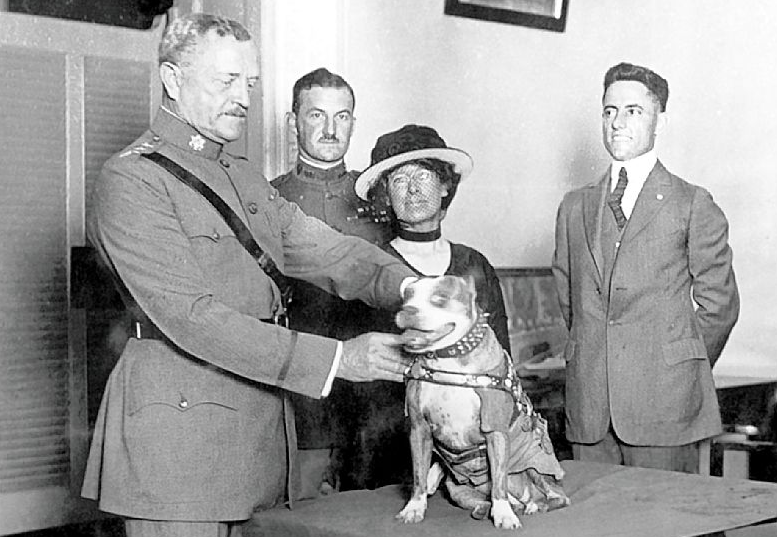Sergeant Stubby: The Most Famous War Dog in History
Sergeant Stubby was not just a dog; he was a true war hero. During World War I, this brave stray dog became the mascot of the 102nd Infantry Regiment of the U.S. Army. He showed courage, loyalty, and intelligence that earned him fame as one of the most honored war dogs in American history. His story is inspiring because it shows how even a stray dog can make a big difference in the world.
Early Life and Birth
The exact birth date of Sergeant Stubby is not known, but historians believe he was born in 1916. He was a short, stocky dog of mixed breed, often described as a Boston Terrier–American Bull Terrier mix. He got his name “Stubby” because of his short tail.
Stubby was a stray dog who wandered the streets of New Haven, Connecticut. He had no owner and no home. His life changed forever in 1917 when he met soldiers training at Yale University before being sent to fight in World War I.
How Stubby Joined the Army
One day, Stubby followed a group of soldiers to the training ground at Yale. The soldiers of the 102nd Infantry quickly grew fond of him because of his friendly nature and playful energy. Private Robert Conroy, a young soldier, adopted Stubby and cared for him.
Stubby learned military routines by watching the soldiers. He could understand bugle calls, march with the troops, and even salute by raising his paw to his head. The soldiers loved him so much that Conroy decided to secretly bring him to France when the unit was sent overseas.
Stubby in World War I
When the 102nd Infantry Regiment left for Europe in 1917, Stubby was smuggled aboard the ship by Private Conroy. Instead of being thrown off, Stubby was allowed to stay because he had already won the hearts of the men and officers.
In France, Stubby served on the front lines with the soldiers. His bravery and intelligence quickly turned him from a mascot into a real soldier.
Warning Soldiers of Gas Attacks
One of Stubby’s most important duties was warning soldiers of mustard gas attacks, which were deadly in the war. His sensitive nose could smell the gas before humans noticed it. When he sensed danger, Stubby barked and alerted the soldiers, saving many lives.
Finding Wounded Soldiers
Stubby also helped in locating injured men on the battlefield. He would run across no-man’s-land, find wounded soldiers, and bark to call medics. Sometimes, he even stayed beside the injured until help arrived, offering comfort to the suffering soldiers.
Boosting Morale
Life in the trenches was hard, but Stubby lifted the soldiers’ spirits. His playful energy and loyalty gave the men hope and courage during dark times.
Acts of Bravery
Stubby became famous for his acts of courage:
-
He once caught a German spy by grabbing him by the seat of his pants and holding him until American soldiers arrived.
-
He took part in 17 battles and four major offensives during the war.
-
Despite being injured by shrapnel, Stubby recovered and returned to the front lines.
Because of these heroic acts, he became loved not just by his unit but also by soldiers all across the Allied forces.
Military Rank and Honors
Stubby is the only dog in American history to be promoted to Sergeant through combat. He received the rank after capturing the German spy.
He also earned many medals and honors, including:
-
A medal from General John J. Pershing, commander of the American Expeditionary Forces.
-
Recognition from the French and other Allied governments.
-
Numerous unofficial medals created by soldiers and supporters.
Stubby proudly wore his own decorated coat, which displayed all his medals.
Return to America
After the war ended in 1918, Stubby returned home with the soldiers. He became a national hero. Newspapers wrote about him, and he marched in military parades. He even met three U.S. Presidents: Woodrow Wilson, Warren G. Harding, and Calvin Coolidge.
Stubby traveled with Private Conroy to events and became a symbol of bravery, loyalty, and the bond between soldiers and animals.
Later Life and Death
After the war, Stubby lived with Robert Conroy and continued to make public appearances. He became the official mascot of Georgetown University, where Conroy studied law. Stubby often entertained the crowds during football games by pushing a football with his nose across the field.
Stubby died in March 1926, at around 10 years old. His death was mourned by the nation. Instead of being forgotten, he was preserved and placed on display at the Smithsonian Institution’s National Museum of American History in Washington, D.C. Visitors can still see him today.
Legacy of Sergeant Stubby
Sergeant Stubby’s story remains an important part of American history. His courage and loyalty remind us that heroes come in all forms, not just human.
-
He is remembered as the most decorated war dog of World War I.
-
He inspired future generations of working dogs in the military, police, and rescue services.
-
Books, documentaries, and even an animated film titled “Sgt. Stubby: An American Hero” have been made to honor his memory.
Stubby represents bravery, love, and sacrifice. His life shows how animals can form deep bonds with humans and play vital roles in society.
Conclusion
Sergeant Stubby was more than just a stray dog; he was a soldier, a hero, and a friend. From a homeless pup on the streets of New Haven to a decorated war hero, his journey is one of the most inspiring stories in history. He saved lives, boosted morale, and became a symbol of loyalty and courage.
Even today, nearly a century after his death, Stubby continues to inspire people around the world. His story teaches us that no matter where we come from or what we look like, bravery and loyalty can turn anyone into a true hero.


